Gnawing material for rabbits
- Ordered before 5 p.m., shipped the same day!
- Al 14 jaar een begrip!
- Delivery from our own stock
- Ordered before 5 p.m., shipped the same day!
- Al 14 jaar een begrip!
- Delivery from our own stock
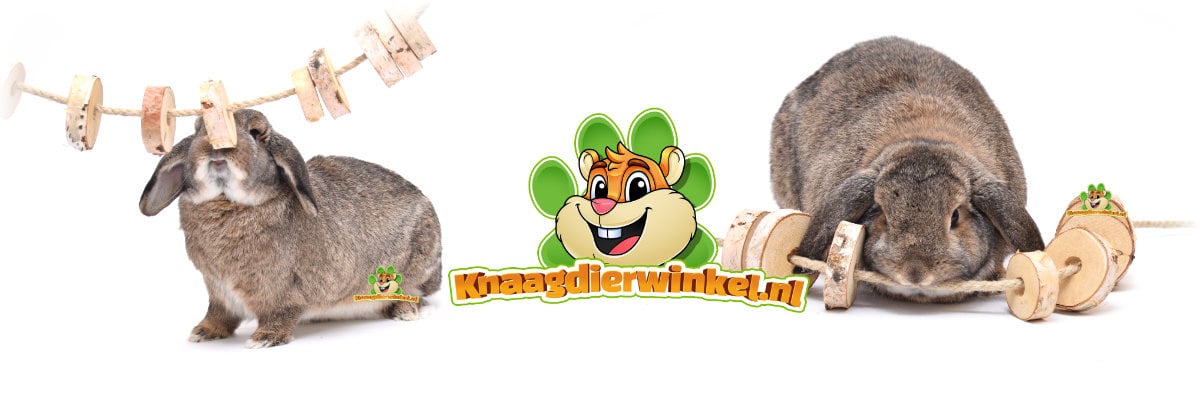 Discover Responsible Gnawing Material for your Rabbit at DRD Knaagdierwinkel® - The Rabbit Webshop for your Beloved Housemate!
Discover Responsible Gnawing Material for your Rabbit at DRD Knaagdierwinkel® - The Rabbit Webshop for your Beloved Housemate!
Rabbits have a natural need to gnaw. The Rabbit is not officially a rodent, but it does have continuously growing incisors. It is therefore necessary for rabbits to have something to gnaw on to wear down their teeth. If rabbits have too few opportunities to wear down their teeth, the teeth can become too long or grow crooked, with all the consequences that entails.
Gnawing is not only a pleasant activity for rabbits; it is also essential for their health. Although rabbits are not officially rodents, they have continuously growing incisors. This characteristic makes it necessary that rabbits always have the opportunity to gnaw on something to wear down their teeth. If rabbits do not have sufficient chewing options, their teeth may become too long or grow crooked, with all the associated adverse consequences.
Gnawing wood is used by rodents to wear down their teeth. Because rodents' teeth are always growing, they need to be gnawed regularly so that they do not grow too long and crooked.
Some Rabbits gnaw wood very actively and others not at all. On the one hand it is a matter of taste, but on the other hand it is a matter of need. If a Rabbit has no need to gnaw because its teeth are kept at their length through food, hay or other nibbles, it will gnaw less on wood. It is good to always provide natural gnawing wood so that the animals can always gnaw when they need to gnaw. If they do not have suitable gnawing wood at their disposal, the rabbits may gnaw on surfaces where this is not desired.
Gnawing wood is a favorite among rodents and is used to naturally maintain their teeth. Since rabbits' teeth are constantly growing, they need regular gnawing material to prevent their teeth from growing too long and developing improper growth.
Rabbits' gnawing behavior can vary from very active to barely present, depending on individual taste and needs. Rabbits with healthy gnawing behavior often keep their teeth at the correct length through their diet, hay or other nibbles. Rabbits that have less need to gnaw will visit the gnawing wood less often. Despite individual differences in gnawing behavior, it is always advisable to make natural gnawing wood available. This allows the rabbits to gnaw when they feel the need to and prevents them from gnawing on unwanted surfaces.
At DRD Knaagdierwinkel® we understand the importance of responsible rodent material for your rabbit. We offer a wide range of options so you're sure to find the perfect choice for your furry friend. Here we want to tell you more about the importance of gnawing materials, the different options available, and how you can ensure that your rabbit always has the opportunity to fulfill its gnawing needs.
How fast do rodents and rabbits grow teeth?
Mice : About 0.3 millimeters per day
Hamsters : About 0.3 millimeters per day
Gerbils : About 0.4 millimeters per day
Rats : About 0.5 millimeters per day
Guinea pigs : About 2 to 3 millimeters per week
Rabbits : About 2 to 3 millimeters per week
Chinchillas : About 1.5 millimeters per week
Degus : About 1.5 millimeters per week
Why does your rabbit need gnawing material?
Gnawing material is essential for the health of your rabbit. Here are some reasons why providing gnawing material is so important:
-
Tooth Wear: Rabbits, as mentioned earlier, have continuously growing incisors. Without the ability to gnaw, these teeth can grow too long, which can lead to painful dental problems and chewing problems.
-
Mental stimulation: In addition to the physical aspect, gnawing is also important for the mental stimulation of rabbits. Gnawing material allows them to keep themselves busy and satisfy their curiosity.
-
Boredom: Rabbits have a tendency to get bored quickly. Gnawing material provides distraction and prevents them from becoming bored, which can lead to unwanted behavior such as gnawing on cages and furniture.
-
Healthy digestion: Gnawing materials, such as hay and branches, contain fibers that are essential for healthy digestion. Gnawing fiber-rich material aids in the natural movement of food through the digestive system.
-
Comfort: For rabbits, gnawing is also a form of comfort. It gives them a feeling of security and well-being, similar to having a hug for children.
-
Preventing dental problems: By offering your rabbit gnawing material, you help prevent dental problems. Long-term dental problems can lead to serious discomfort and health problems.
It is important to understand that gnawing material is not a luxury, but a necessary part of caring for your rabbit. It contributes to their physical and mental well-being and can prevent problems that would otherwise lead to vet visits. Therefore, always make sure that your rabbit has access to suitable gnawing material.
Different types of gnawing material
Now that you understand why gnawing materials are so important for your rabbit, let's look at the different types of gnawing materials you can choose from:
-
Hay : Hay is one of the most essential forms of gnawing material for rabbits. It is rich in fiber and not only helps with tooth wear, but also supports healthy digestion. Various types of hay are available, including Timothy hay, Alpine meadow hay and hay mixed with herbs. A variety of hay types can maintain your rabbit's interest.
-
Branches: Branches of fruit trees or other safe plants are also excellent gnawing material. Make sure you only use branches from plants that are free of pesticides and toxins. Popular choices include apple and willow branches.
-
Gnawing wood: Specially designed gnawing wood, such as willow bridges and gnawing stones, are ideal for rabbits. These products are made of safe wood and offer your rabbit a fun challenge.
-
Nibble rolls and balls: These rolls and balls are filled with hay or other gnawable materials. They provide both physical and mental stimulation and keep your rabbit busy.
-
Gnawing toys: There are numerous types of gnawing toys available, from wooden puzzles to woven grass balls. These stimulate your rabbit's gnawing behavior and provide entertainment.
It is advisable to offer several types of gnawing material so that your rabbit has variety and is stimulated. Moreover, you can experiment to find out which types of gnawing materials your rabbit likes best.
An Overview of Our Gnawing Wood Varieties
-
Linde: Loved for its smooth texture and taste, Linde provides a pleasant chewing experience for rabbits. Linden wood is known for its soft and light texture. It offers a mild gnawing sensation, making it suitable for all rabbits who like softer materials. Basswood has a light and mild flavor, making it attractive to animals without a strong preference.
- Apple: Apple wood is a popular choice as a gnawing material for rabbits. Applewood generally has a medium texture. It offers satisfactory resistance to gnawing, which is ideal for animals that like to actively grind their teeth. In addition, apple wood has a mild and pleasant taste. This subtle flavor can arouse Rabbits' curiosity, causing them to enjoy gnawing on the wood.
-
Willow: With its crispy bark and juicy interior, Willow is a favorite choice for rabbits who enjoy active gnawing. Willow wood has a crispy bark and a soft core. It provides a varied texture that the animals can appreciate. Willow wood has a natural and light taste, which makes it attractive to gnawing rabbits.
- Coffeewood : Coffeewood, made from coffee plants and generally has a soft and smooth texture which is very interesting for Rabbits. The taste of Coffeewood is a natural, earthy taste. Rabbits can certainly appreciate this taste while gnawing. Coffeewood is also known for its durability, it lasts a long time as a chewing material.
-
Hazelnut: Hazelnut gnawing wood combines strength with flavor, making it a sustainable and tasty choice for your gnawing friends. Hazelnut wood has a firm texture. It offers good resistance for rabbits that like to actively gnaw. Hazelnut wood has a characteristic taste that rabbits can appreciate.
-
Birch: Birch's light and airy character makes it a versatile choice, perfect for rabbits with different gnawing preferences. Birch wood has a light and airy texture. It is suitable for animals that prefer slightly less dense materials. Birch wood has a mild flavor, making it a versatile choice for a variety of rabbits.
-
Beech: With its sturdy structure, Beech offers a long-lasting chewing challenge for rabbits that like to be challenged. Beech wood has a sturdy and durable texture. It offers long-lasting gnawing pleasure and is suitable for animals that like a challenge. Beech wood has a neutral taste, which makes it attractive to animals without a clear preference.
-
Wood and Branches of Herbs: For animals that like a tasty variety, wood and branches of herbs offer a combination of gnawing pleasure and aroma.
How do you use gnawing wood for rabbits?
-
Placement in the enclosure: Simply place the gnawing wood in your animals' enclosure. They will instinctively nibble on it when the need to gnaw arises.
-
Durability: Gnawing wood lasts a long time and does not need to be replaced every time the enclosure is cleaned. Only wet gnawing wood must be removed to prevent mold formation.
Gnawing wood from the garden or picking outside?
We strongly advise against picking wood from the garden or outside. Our gnawing wood is harvested and cleaned under protected conditions, making it free from possible parasites and contaminants that can occur in nature. Using our carefully selected gnawing wood ensures a safe and healthy gnawing experience for your animals.
Order Now and Let Your Rabbits Enjoy Natural Gnawing Fun!
Give your rabbits the gifts of nature with our diverse range of gnawing wood. Order today and watch your Rabbits enjoy the gnawing adventure!
How can you ensure that your rabbit always has access to gnawing material?
Providing gnawing material is one thing, but making sure your rabbit always has access to it is just as important. Here are some tips to ensure that your rabbit can always chew:
-
Hay rack : Place a hay rack in your rabbit's enclosure. This ensures that hay is always available and prevents waste.
-
Branches and gnawing wood: Place branches and special gnawing wood in the enclosure. Make sure your rabbit has enough space to gnaw without restrictions.
-
Gnawing toys: Introduce gnawing toys into your rabbit's enclosure. This can include wooden toys as well as nibble rolls and balls.
-
Regular replacement: Regularly check the condition of the chewing material. Replace worn or eaten items to ensure your rabbit always has something to gnaw on.
-
Variety: Offer different types of gnawing material to maintain your rabbit's interest. Alternate between hay, branches and chewing toys.
It is important to keep the gnawing material clean and to ensure that it is safe for your rabbit. Remove any sharp edges or loose pieces to avoid choking hazards.
Gnawing material is an essential part of caring for your rabbit. It not only helps with tooth wear, but also provides mental stimulation, prevents boredom and contributes to healthy digestion. By giving your rabbit access to different types of gnawing material and ensuring that it is always available, you can contribute to the well-being and health of your beloved housemate.
At DRD Knaagdierwinkel® we understand the needs of rabbits and we offer an extensive range of gnawing materials, including hay, branches, gnawing wood and gnawing toys. We are ready to help you make the best choices for your rabbit so that it can gnaw happily and healthily. Discover our range and give your rabbit the gnawing challenge it deserves! Your beloved roommate will thank you for it.





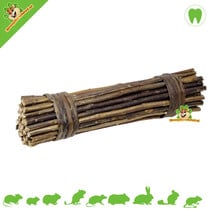
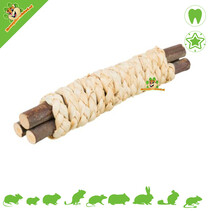


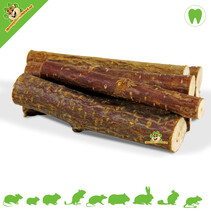
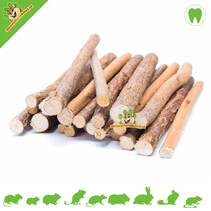



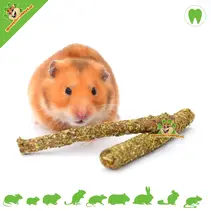
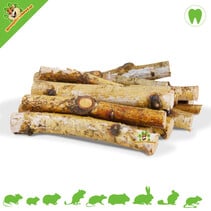

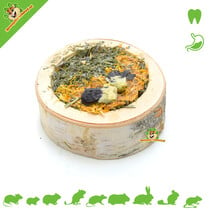
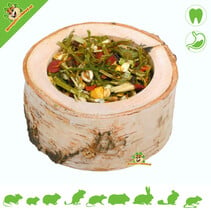

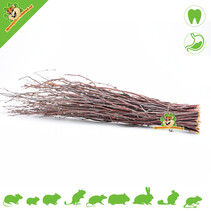

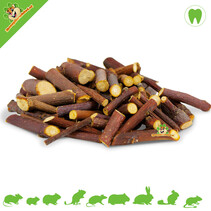
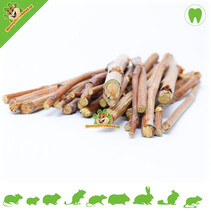

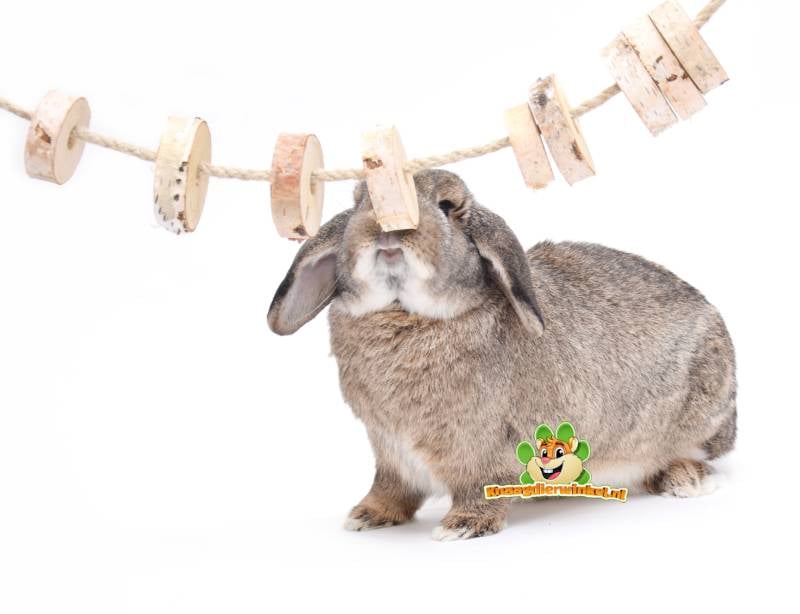 Save
Save